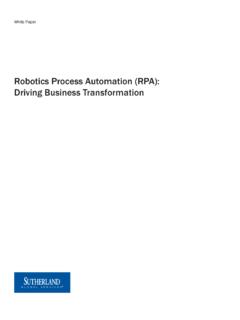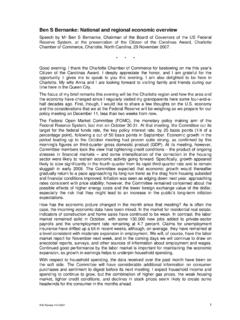Transcription of Industry Trends Report - mitchell.com
1 Industry TrendsReport OE Versus Aftermarket Part Price Deltas: In Search of the Big DealBy Nate RaskinSenior Manager, Analytics, Mitchell Auto Physical DamageAPD EditionVolume Seventeen Number TwoPublished by Mitchell InternationalQ2 2017 Volume Seventeen Number TwoThe Industry Trends Report is published by information contained in this publication (i) was obtained from sources deemed reliable; (ii) is provided for informational purposes only; (iii) should not be construed as legal or regulatory advice on any specific subject matter; and (iv) Mitchell does guarantee the accuracy or completeness of the information provided. You should not act on the basis of any content in the publication without seeking legal or other professional advice to address a specific customer issue. This publication is intended to provide general information and may not reflect the most current legal or regulatory environment or address your situation specifically.
2 Mitchell disclaims all liability for a customer s acts or omissions related to the content of this publication. Mitchell and the Mitchell logo and all associated logos and designs are registered and unregistered trademarks of Mitchell International, Inc. All other trademarks, service marks and copyrights are the property of their respective Trends Repor tTable of Contents 4 Artificial Intelligence Gets Real Three Ways AI Is Making Inroads in P&C Claims 8 OE Versus Aftermarket Part Price Deltas: In Search of the Big Deal 11 Vehicle Scanning for a Computer Network on Wheels 14 Average Length of Rental for Repairable Vehicles 18 Current Events in the Collision Industry 22 Motor Vehicle Markets 24 Mitchell Collision Repair Industry Data 31 Total Loss Data 32 Canadian Collision Summary 36 About Mitchell 37 Mitchell in the NewsA Message from the CEOAI s Industry ImpactWelcome to the Q2 edition of the 2017 Mitchell Auto Physical Damage Industry Trends Report .
3 In this issue, we start off by exploring a topic that is top of mind for many in the Property & Casualty Industry , artificial intelligence (AI). From computer vision to natural language processing, there are numerous applications for AI, and since many organizations are turning their investment focus to it, we asked our general managers to explain how it s beginning to be used in the Industry today. In our feature article, OE Versus Aftermarket Part Price Deltas: In Search of the Big Deal, author Nate Raskin asks whether aftermarket parts still represent the largest opportunity for collision repair cost savings. By focusing his analysis on the price gaps between OE and aftermarket parts over the last seven years, Nate shows how increased competition has shrunk the gap. While there is still opportunity for savings, it s not at the same level as in years this issue, we also look at how increased vehicle complexity has fueled the debate around the need for pre- and post-repair scanning.
4 We share the current options available for collision repairers and how many in the Industry believe that in-house scanning tools are a must for safe and complete repairs. Thank you for your continued readership of the Industry Trends Report and I look forward to sharing more insights on exciting changes in the Industry and what they may mean for your business as the year progresses. Alex Sun President and CEO MitchellQ2 2017 Alex Sun President and CEO, MitchellView the Casualty EditionFOR MANY OF US, ARTIFICIAL INTELLIGENCE (AI) STILL SEEMS LIKE THE STUFF OF SCIENCE FICTION, BUT IN REALITY, WE INTERACT WITH AI EVERYDAY THROUGH DEVICES LIKE AMAZON ECHO AND GOOGLE HOME. Gartner named AI a top strategic trend for 2017, and according to a recent study by Accenture, 85 percent of insurance executives surveyed plan to invest significantly in artificial intelligence over the next three years. The value of AI applications in insurance is clear it supports human decision making in a multitude of ways that could streamline the claims process, reduce fraud, and result in the better all-around outcomes for both claimant and insurance company.
5 The insurance Industry itself is at an inflection point in terms of AI. There are so many AI-related technologies, they are all in different stages of development, and there are many things they can and can t do yet. The first step is to understand what each of these technologies is and where they have the potential to impact the claims , let s cover the basics: artificial intelligence is a broadly used term to describe the concept of machines carrying out activities that would normally require human intelligence to do. There are many different technologies that are considered AI. In this article, the general managers of each of Mitchell s business units break down a few of these technologies computer vision, machine learning and natural language processing and explain how they are beginning to be used in the P&C vision is driving more than just self-driving carsBy Debbie DayMachine learning is powering intelligent claims processesBy Dave TorrenceNatural Language Processing Isn t Just for Customer Service AnymoreBy Nina SmithArtificial Intelligence Gets Real Three Ways AI Is Making Inroads in P&C ClaimsThe insurance Industry has plenty of data, but turning that data into actionable insights is easier said than done.
6 That s where machine learning comes in. Very simply put, machine learning is a field of computer science that enables computers to learn without being explicitly programmed to do so. It can quickly review large quantities of data, organize it, extract information from it, and even make recommendations. But to really understand the value of machine learning, it s helpful to understand the types of problems it can solve and insights it can glean. Here are a couple of examples: Machine learning can be used to make predictions. By analyzing historical prescribing patterns and claim outcomes, it could be used to identify claimants at risk of opioid abuse. This would make it possible to intervene with clinical programs and prevent the abuse early in the process or prevent it all together. By Dave Torrence, Executive Vice President and General Manager, Pharmacy Solutions and Strategy & TransformationVERY SIMPLY PUT, MACHINE LEARNING IS A FIELD OF COMPUTER SCIENCE THAT ENABLES COMPUTERS TO LEARN WITHOUT BEING EXPLICITLY PROGRAMMED TO DO SO.
7 Machine learning can be used to generally detect anomalies identifying anything on a claim that is atypical or just odd. By flagging claims in this way, anomaly detection can be used for a wide range of purposes, from clinical intervention to detecting fraud to just alerting an adjuster to review a file. These are just a few, simple examples the possibilities are limitless. Machine learning could potentially impact almost every stage of the claims process. And each step is a step closer to an intelligent claims process, one in which decisions are made more quickly, with greater efficiency, and with better outcomes for insurer and learning is powering intelligent claims processesBy Debbie Day, Executive Vice President and General Manager, Auto Physical DamageOne reason artificial intelligence is particularly relevant to the P&C and collision repair Industry is because of the role it plays in computer vision and one of the most relevant applications for computer vision is self-driving cars.
8 Computer vision basically seeks to enable computers to see images and extract information from them, in much the same way a human does. It goes beyond sensors that simply capture data. It layers in deep learning the ability to actually perceive, interpret and respond to what s happening in the environment. The ability is essential for vehicles to be truly there are other use cases for computer vision in insurance ones that are having an immediate impact on the claims process. Take, for example, a couple of steps in the physical damage claims process that are based primarily on visual inspection: first notice of loss and repair vs. replace technology available today, photos taken by consumers and submitted via mobile device as part of first notice of loss could be used to inform a decision about whether or not the vehicle should be declared a total loss, potentially saving a costly tow to a repair facility.
9 Similarly, these images could be used to determine whether to repair or replace a damaged these are just two use cases, a recent Report by Trac tica indicates that the global computer vision market is expected to grow to $ billion by 2019. Ultimately, both insurer and insured benefit from a streamlined claims process, and computer vision is just one of the many AI technologies available to deliver on that. For more of Debbie s thoughts on artificial intelligence and computer vision, read her blog post: Computer Vision from Diagnosing Cancer to Transforming the Claims COMPUTER VISION MARKET IS EXPECTED TO GROW201920182017$33 billion$12 billion$20 billionComputer vision is driving more than just self-driving carsFrom Geico s virtual assistant, Kate, that answers basic policy and billing questions within an app, to Lemonade s chatbot, Maya, that signs people up for renters insurance and even processes simple claims, virtual assistants and chatbots are proliferating in the insurance Industry .
10 In fact, in a recent Accenture study of the insurance Industry , 68 percent of respondents said their companies use some sort of AI-powered virtual assistant in at least one segment of their technology that enables chatbots to interpret language is called natural language processing (NLP). NLP hasn t yet advanced to the point where it can understand complex conversational language, but it can understand, ask questions and provide suggestions within a given context. Despite its limitations, it is already beginning to move out of the customer experience arena and into the enterprise in really interesting ways. Companies like Tableau Software and Rhiza are finding ways to integrate it into data analysis, and they are even incorporating voice interfaces think Amazon Echo and Google Home along the way. By Nina Smith, Executive Vice President and General Manager, Casualty SolutionsOF THE INSURANCE Industry USE SOME SORT OF AI-POWERED VIRTUAL ASSISTANT IN AT LEAST A SEGMENT OF THEIR s prototype software, Eviza, enables users who are looking at data visualizations, like points on a map showing earthquakes, to use basic queries to drill into the data along the lines of show me the area that had the strongest earthquake.






